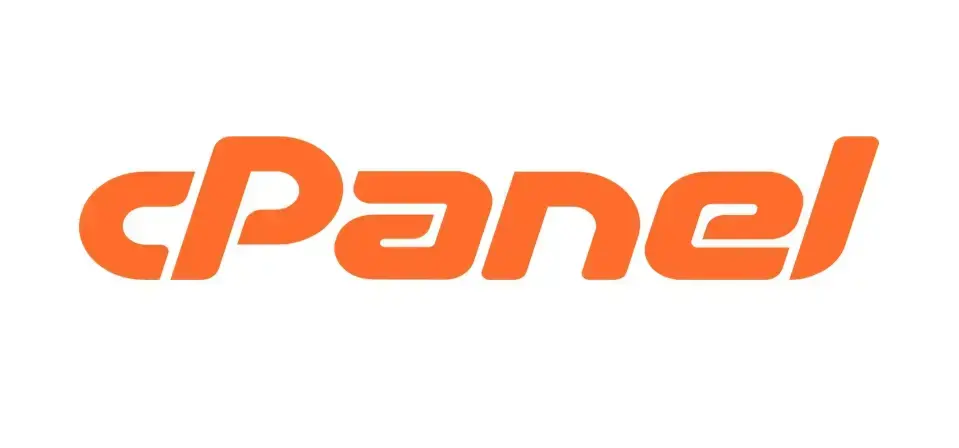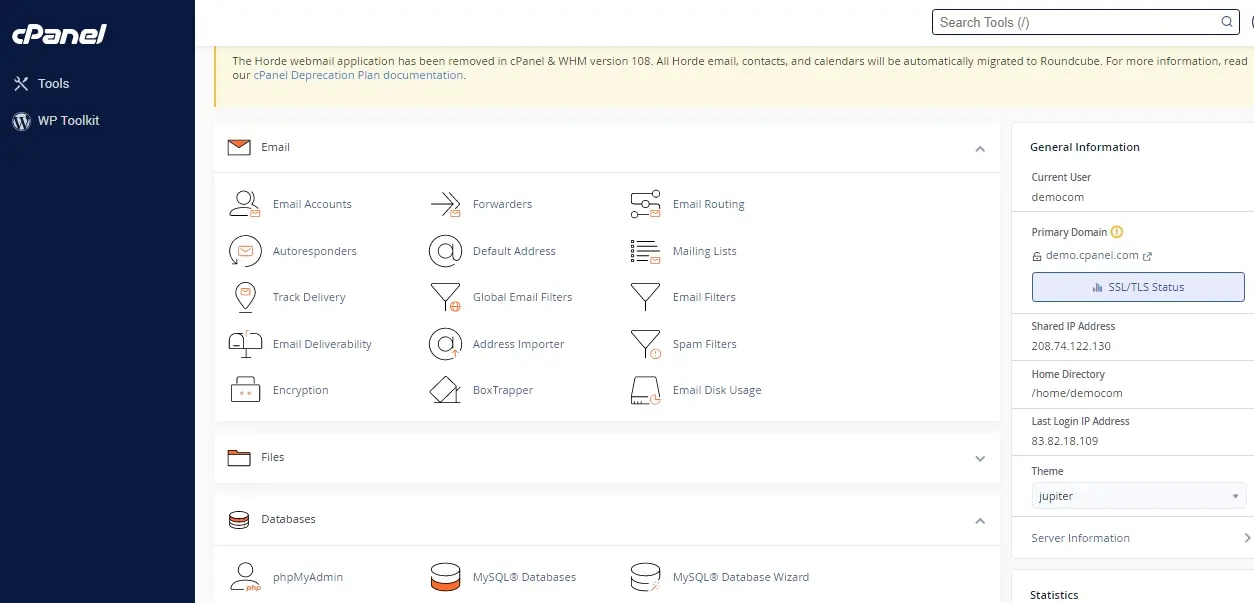The tools you use to manage your web hosting environment can significantly impact how efficiently your business operates and scales. A web hosting control panel is central to managing your online presence, influencing everything from website performance to security.
cPanel, recognized for its comprehensive features and strong reseller support, commands about 27.18% of the control panel market, making it a trusted choice for many businesses and hosting providers like Verpex Hosting.
In contrast, zPanel offers a simpler, open-source solution for users who prioritize cost-effectiveness and flexibility. This comparison explores the strengths and weaknesses of these two popular control panels, helping you determine which one best aligns with your specific needs.
Key Features of a Web Hosting Control Panel
1. Database Management: A control panel should provide tools for managing databases, including creating and deleting databases and managing user privileges. This feature enables users to store and manage data for their website applications.
2. Domain Management: Control panels provide tools for managing multiple domains and subdomains, allowing users to easily configure domain-related settings, including redirects, DNS records, and SSL certificates, all from a centralized location.
3. Email Management: They allow users to create, manage, and secure email accounts associated with their domains, including features like spam filters, autoresponders, and email forwarding, ensuring smooth and secure communication.
4. File Management: Control panels typically include file management systems that enable users to upload, download, and manage website files directly on the server. These systems often include features like FTP access and file editors.
5. Security Features: These panels often come with built-in security tools, such as firewalls, SSL certificate management, and malware scanners, to help protect websites from cyber threats and ensure secure data transmission.
Brief Comparison Between cPanel and zPanel
| Feature/Aspect | cPanel | zPanel |
|---|---|---|
| User Interface | Intuitive, feature-rich, but slightly dated | Simple, lightweight, easy to navigate |
| Cost | Paid, premium product | Free, open-source |
| Support | Extensive official support and community | Limited community-driven support |
| Security | Advanced security features, frequent updates | Basic security tools, slower patch releases |
| Customization | Highly customizable, large plugin ecosystem | Limited customization, fewer plugins |
| Server Performance Management | Advanced resource management tools | Basic resource monitoring and management |
| Multi-Server Management | Supports multi-server management, but complex | Primarily single-server management |
| Integration | Seamless integration with numerous third-party tools | Fewer integrations, potential manual setup |
| Market Share | ~70% of the market share | Smaller segment, niche market |
| Best Use Cases | Web hosting companies, SMEs, developers | Small websites, personal projects, educational use |
| Ease of Installation | Requires some technical knowledge | Straightforward, user-friendly installation |
cPanel

Since its inception in 1996, cPanel has evolved into the industry’s leading web hosting control panel, celebrated for its extensive features, intuitive interface, and robust security. Dominating a significant share of the market, cPanel powers a large portion of websites using a control panel, making it the preferred choice for hosting providers, individual users, and resellers.
Its widespread adoption and reliability have earned it the trust of a diverse range of users, solidifying its position as the go-to solution for web hosting management and reseller operations alike.

Key Features and Functionalities
File Management: Manage files, create backups, and edit files directly within cPanel using FTP, SFTP, or the File Manager.
Email Management: Create and manage email accounts with secure features like SSL/TLS encryption and spam filtering.
Security Features: Includes password protection, IP blocking, SSL/TLS certificates, two-factor authentication, and SSH access.
Software Installation: One-click installation for popular web applications like WordPress and Joomla<a/>.
Settings and Configuration: Customize settings such as language, timezone, and server configurations.
Server Performance and Resource Management in cPanel
1. Resource Allocation and Quotas: cPanel lets administrators set limits on resources like CPU, memory, and bandwidth to ensure that no single account consumes too much, keeping the server running smoothly.
2. Optimized Web Server Configurations: cPanel supports high-performance servers like LiteSpeed and Apache<a/>, allowing users to fine-tune settings for faster website loading and reduced server strain.
3. Load Balancing: cPanel can distribute incoming traffic across multiple servers, preventing any single server from being overwhelmed during high-traffic times.
4. Automated Task Scheduling: With Cron Jobs, cPanel allows tasks to be automated during off-peak hours, minimizing their impact on server performance.
5. Caching Mechanisms: cPanel integrates caching tools like Varnish and Memcached, which store frequently accessed data to reduce server load and speed up response times.
Benefits and Limitations of Implementing cPanel
Benefits
Limitations
Benefits of Implementing cPanel
Automation and Scripting: cPanel offers automation and scripting tools that allow users to automate repetitive tasks, saving time and increasing efficiency. It supports various scripting languages, such as PHP, Perl, and Python, making it easy for users to automate tasks and customise their hosting experience.
Reseller and Multi-User Support: cPanel offers robust reseller and multi-user support, making managing multiple accounts and clients easy. This is particularly useful for web hosting companies and resellers.
Integrated File Manager: cPanel's integrated file manager makes it easy to manage files and directories, including uploading, downloading, and editing files. This eliminates the need for external FTP clients.
Integration with Third-Party Tools: cPanel integrates seamlessly with various third-party tools and services, such as WordPress, Joomla, and Google Analytics. This makes it easy for users to incorporate their favourite tools and services into their hosting experience.
Extensive Customisation: cPanel allows users to customise their hosting experience with various themes, plugins, and extensions. Users can also customise their control panel to suit their specific needs. This flexibility makes cPanel a great choice for users with unique requirements.
Limitations of Implementing cPanel
1. Integration Challenges: cPanel may not seamlessly integrate with all third-party tools and services, potentially requiring additional plugins or workarounds to achieve desired integrations. This can add complexity and potential stability issues.
2. Backup and Restore Complexity: cPanel's backup and restore features can be complex to configure and manage, potentially leading to data loss or corruption if not properly set up. Users must carefully plan and test their backup and restore strategies.
3. Multi-Server Management Complexity: cPanel is primarily designed for single-server management, making it cumbersome to manage multiple servers, potentially leading to administrative overhead and errors. Additional tools or plugins may be necessary to achieve efficient multi-server management.
4. Dependence on cPanel's Ecosystem: cPanel's vast ecosystem of plugins and themes can be a double-edged sword, as users may become reliant on specific plugins or themes that can be abandoned or discontinued, leaving users without support or updates. Users must carefully evaluate plugin and theme dependencies.
Use Cases of cPanel
1. Web Hosting Companies
cPanel is a great fit for web hosting companies offering shared, VPS, or dedicated hosting services to their customers. It provides an intuitive interface for customers to manage their websites, emails, and databases while offering robust features for administrators to manage servers and clients. cPanel's automation and scripting capabilities are ideal for large-scale hosting operations.
2. Resellers
cPanel is a great fit for resellers that offer clients web hosting and development services.
It provides a customisable and white-labelable control panel that can be branded to match the reseller's identity. cPanel's features, such as package management, client management, and billing integration, also make it ideal for resellers and agencies.
3. Developers and Designers
cPanel is suitable for developers and designers who require a control panel to manage their clients' websites and applications.
It offers features like version control, Git integration, and API access that are essential for developers while also providing design tools like website builders and templates. cPanel's flexibility and customisation options are ideal for developers and designers.
4. Educational Institutions
cPanel is a great fit for institutions requiring a control panel to manage their students' and faculty's websites and projects.
It provides an intuitive interface that is easy to learn, offering features like multi-user support, resource limits, and security controls essential for educational environments. cPanel's customisation options allow institutions to tailor the control panel to their needs.
zPanel

zPanel's evolution began as a lightweight, open-source alternative to traditional control panels, gaining popularity through its simplicity and ease of use. It eventually became a widely adopted solution in the web hosting industry.
Despite being a relatively new player, zPanel has carved out a significant market share, attracting hosting providers and users seeking a streamlined, user-friendly experience. In the market, zPanel is an accessible, easy-to-use solution for small to medium-sized businesses and individuals.
At the same time, cPanel targets a broader audience, including larger enterprises and hosting providers requiring advanced features and customisation.

Key Features and Functionalities of zPanel
Bandwidth Management: Monitor and manage bandwidth usage across different domains or user accounts.
Subdomain Management: Simplified creation and management of subdomains.
SSL Certificate Management: Tools for managing SSL certificates, ensuring secure connections.
PHP Configuration: Configure PHP settings directly from the control panel.
Security Features: Includes brute-force detection, firewall rules, geoIP blocking, and secure password storage.
Server Performance and Resource Management in zPanel
1. Resource Usage Monitor: This feature lets users track the real-time usage of critical server resources like CPU, memory, and bandwidth. By monitoring these metrics, users can quickly identify and address any resource-heavy processes to keep the server running smoothly.
2. Process Manager: Users can easily view and manage running processes, with the ability to stop or restart any that are overusing resources, ensuring that the server remains responsive and efficient.
3. Disk Quotas: zPanel allows administrators to set limits on disk space for individual accounts, helping prevent any one user from consuming too much space, which keeps the server stable and prevents overload.
4. Bandwidth Throttling: This tool enables users to cap bandwidth usage for specific accounts, which helps manage overall traffic and ensures the server is not overwhelmed by any one user.
5. Caching: By enabling caching for frequently accessed data, zPanel helps reduce server load and speeds up response times, leading to better overall performance.
Benefits and Limitations of Implementing zPanel
Benefits
Limitations
Benefits of Implementing zPanel
1. Cost-Effective: zPanel is open-source and free to use, which makes it a budget-friendly option for users and small businesses. It provides essential hosting management features without the need for a paid license.
2. Easy Installation: zPanel provides a straightforward installation process with clear instructions, making it accessible even for those who are not highly technical. This simplicity helps reduce setup time and complexity.
3. Multi-Platform Support: zPanel supports various operating systems, including Windows, Linux, and Mac OS X, providing flexibility for users with different server environments. This cross-platform capability allows for broader applicability and integration.
4. Open-Source Flexibility: As an open-source platform, zPanel provides users with greater customisation options. It allows integration with various third-party applications and services, enhancing website functionality.
5. Built-In Security Features: zPanel includes essential security measures such as user authentication and secure communication protocols. These features help protect the server from unauthorised access and potential security threats.
Limitations of Implementing zPanel
Limited Community Support: While zPanel does have a community, its size and activity level might not compare to those of more established control panels like cPanel or Plesk. This can result in slower response times for support inquiries and fewer available resources for troubleshooting.
Fewer Third-Party Integrations: ZPanel may have fewer pre-built integrations with popular third-party applications and services than larger control panels. This can limit flexibility and require additional configuration efforts.
Potential Performance Issues: Due to its open-source nature and less extensive development resources, zPanel might experience performance limitations compared to commercially supported control panels, especially under heavy load.
Less Mature Software: Compared to commercial control panels with extensive development resources, zPanel might have a less polished and refined user interface. This can result in occasional bugs, glitches, or inconsistencies in functionality.
Security Concerns: As an open-source project, zPanel might have a slower security patch release cycle than commercial control panels. If vulnerabilities are not addressed promptly, users could be exposed to increased security risks.
Use Cases of zPanel
1. Cost-Effective Hosting for Small Websites: zPanel is ideal for users seeking an affordable, user-friendly control panel to manage small to medium-sized websites without complex requirements. Its straightforward interface and low resource usage suit budget-conscious individuals and small businesses.
2. Learning and Development Environments: zPanel is well-suited for educational settings and development environments where students or developers need a simple, no-cost platform to practice and learn web hosting management. Its ease of setup and minimal resource footprint facilitate hands-on experience without financial constraints.
3. Basic Personal Projects and Portfolios: For individuals running personal projects or portfolios, zPanel offers a lightweight and easy-to-navigate solution to manage websites, email accounts, and databases. Its simplicity and lower overhead are perfect for personal use without advanced features.
4. Basic Reseller Hosting: zPanel is suitable for small-scale reseller hosting operations that focus on providing basic web hosting services without advanced requirements. Its intuitive interface allows resellers to manage client accounts and hosting services efficiently and cheaply.
5. Low-Traffic Niche Sites: zPanel excels in managing low-traffic niche websites with unnecessary advanced functionalities. Its minimalistic design and low system requirements make it a practical choice for hosting specialised content with minimal resource consumption.
Best Practices for a Smooth Control Panel Transition
1. Plan Ahead: Before transitioning to a new control panel, plan by assessing your current setup, identifying potential issues, and creating a migration plan. This helps minimise downtime and ensures a smooth transition. A well-planned migration also helps identify potential compatibility issues.
2. Backup Data: Backup all critical data, including website files, databases, and email accounts, before transitioning to a new control panel. This ensures that important data is not lost during the migration process. Verify the integrity of backups to ensure they can be restored if needed.
3. Test and Validate: Test the new control panel in a staging environment before migrating production data. Ensure that all features and functionality work as expected and that the new control panel meets your requirements. This helps identify and resolve issues before they affect production environments.
4. Train Users: To ensure a smooth transition, train users on the new control panel's features, interface, and functionality. Provide documentation, tutorials, and support resources to help users adapt to the new control panel. This will minimise confusion and reduce support requests.
5. Monitor and Optimize: After migration, monitor the new control panel's performance, security, and functionality. Optimize settings, configurations, and workflows to ensure the control panel meets your requirements. Continuously monitor for issues and address them promptly to ensure a smooth user experience.
Conclusion
The choice between cPanel and zPanel depends on your specific hosting needs. For those prioritizing simplicity and cost-effectiveness, zPanel might be sufficient. However, cPanel offers a distinct advantage for businesses and resellers who require advanced features and scalability. Its extensive tools and strong market presence make it a reliable choice for long-term growth.
Verpex Hosting enhances the cPanel experience by offering a seamless integration that benefits both individual users and resellers. By selecting Verpex Hosting with cPanel, you gain access to powerful management tools and customization options that support your business’s growth and efficiency.
Frequently Asked Questions
Can cPanel and zPanel run on different operating systems?
cPanel primarily supports Linux servers and is compatible with several Linux distributions, such as CentOS, Red Hat, and Ubuntu. It does not natively support Windows operating systems, making it ideal for Linux-based hosting environments. On the other hand, zPanel offers support for both Linux and Windows servers, making it a versatile option for those needing to manage hosting on different operating systems.
How do cPanel and zPanel handle SQL database management and PHP configuration?
cPanel provides robust tools for managing MySQL databases, allowing server administrators to easily manage databases through a graphical interface. It also offers extensive PHP configuration options, enabling users to adjust PHP settings directly from the control panel. zPanel also supports MySQL databases and offers basic PHP configuration capabilities, but it might require more manual intervention via the command line interface, especially for advanced settings.
Are there any free alternatives to cPanel and how do they compare?
Yes, there are several free cPanel alternatives available, with zPanel being one of them. zPanel is a free control panel that offers features similar to cPanel, such as domain management, email services, and MySQL database management, but with a simpler interface and fewer advanced options. Other free alternatives include Virtualmin and ISPConfig, which also cater to users on a tight budget or those needing to host multiple domains without incurring licensing costs.
What level of technical support can users expect with cPanel and zPanel?
cPanel users benefit from comprehensive technical support, including a robust ticketing system, an active community, and extensive documentation. This makes it easier for new customers and experienced server administrators alike to resolve issues. In contrast, zPanel, being a free, open-source solution, relies more on community-driven support. While it has an active community, the level of tech support may not be as immediate or thorough as that provided by cPanel’s official channels.

Yetunde Salami is a seasoned technical writer with expertise in the hosting industry. With 8 years of experience in the field, she has a deep understanding of complex technical concepts and the ability to communicate them clearly and concisely to a wide range of audiences. At Verpex Hosting, she is responsible for writing blog posts, knowledgebase articles, and other resources that help customers understand and use the company's products and services. When she is not writing, Yetunde is an avid reader of romance novels and enjoys fine dining.
View all posts by Yetunde Salami




















